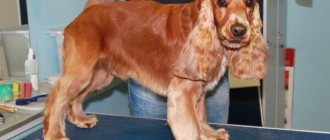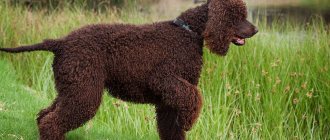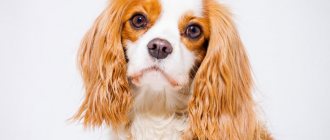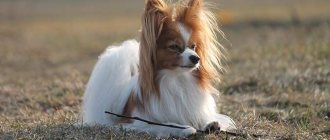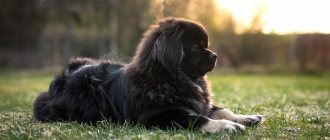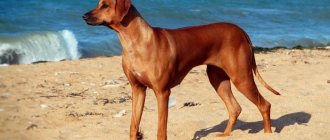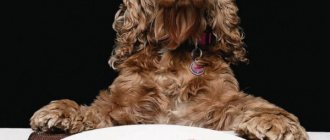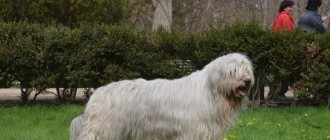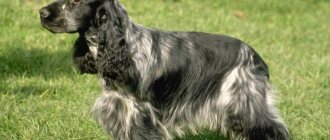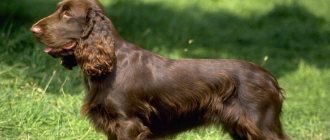History of the Russian Hunting Spaniel breed
Russian hunting spaniel
The appearance of spaniels in Russia is associated with the name of Nikolai Nikolaevich Romanov, the uncle of the last Russian Tsar. Being a keen breeder and leader of several hunting communities, he often brought various breeds of dogs from trips abroad. In particular, a cocker spaniel named Dash, exhibited at the 1885 exhibition, also belonged to the Grand Duke, who purchased the dog from an elite English kennel. Subsequently, it was this male who became the father of several generations of puppies, which were sold to Russian nobles.
With the easy encouragement of N.N. Romanov, the interest of domestic dog breeders in spaniels quickly acquired a practical orientation. Although with some delay, breeders still discovered excellent hunters in dogs, capable of working with any type of bird. In addition, imported cockers and springers performed well in pheasant hunting, which was especially respected by members of the imperial family, so that breeding soon became a profitable and prestigious business.
At first, breeding specimens were imported from England, after which they were haphazardly bred with spaniels from royal and princely nurseries. The offspring obtained as a result of such experiments, although they had a spaniel appearance, bore little resemblance to their foreign parents. Actually, these were the first Russian hunting spaniels - non-standardized, without pedigrees, but with the same working characteristics as modern representatives of the breed.
By the beginning of the 20th century, spaniels born in Russia were exhibited at breeding exhibitions separately from their English relatives. During the same period, the stratification of the unofficial breed into Moscow and St. Petersburg types became especially noticeable. Representatives of each of the “castes” differed both in appearance and in their style of work, which became the reason for further experiments in crossing both varieties.
In the 30s, the Leningrad section of spaniels took up the task of improving the breed, using domestic dogs and imported males for mating: the half-springer Alba von Blummenthal and the cocker spaniel Caesar von der Schmich. Unfortunately, the developments of those years were destroyed by the Great Patriotic War and the blockade, so after the victory the number of animals was restored almost from scratch. The task was also seriously complicated by the heterogeneity of the domestic livestock, which was full of mestizos.
In 1951, Soviet specialists finally fixed the phenotype of the breed and issued the first appearance standard for its representatives. Since 1972, an official ban on mating between Russian hunting and other varieties of spaniels was introduced, which was the last step towards the independence of animals.
Already in the 60s, owning a breed became fashionable among domestic hunters. Compact and extremely prey, such dogs did not create problems with transportation and easily took root in city apartments. And although in the 90s the number of Russian hunting spaniels was reduced to a critical minimum, they were not allowed to completely disappear, taking a number of measures to revive and increase the number of purebred individuals.
Types of Spaniels
Depending on what type of dog the dog belongs to, its description, characteristics and size will differ.
Spaniel varieties:
- The Irish Water Spaniel is one of the largest representatives of the breed. The weight of an adult male reaches 20 kg. The variety was obtained in the 19th century and until now all individuals of this type are not divided into exhibition and working. All dogs are assessed to the same standard. Presumably, “Afghans” were involved in breeding work, whose features can be discerned in the appearance of the Irish Water Spaniel.
- English cocker spaniel. A medium-sized dog, the weight of an adult should not exceed 14.5 kg. The dog is very active, friendly, and has long, silky hair. The standard allows any colors, but a solid color should not have white spots, except for spots on the chest.
- English Springer Spaniel. A hunting dog whose pedigree goes back to the Middle Ages. This is a fearless escort who knows how to pick up game even without a good sense of smell. English individuals have a pure white or black and white color. Shiny spots are allowed.
- American Cocker Spaniel. A small dog with thick long hair. Dogs of this subspecies are extremely beautiful, so they are rarely used for hunting. Raising a spaniel usually comes down to having fun with family members and walks in the nearest park.
- Welsh Springer Spaniel. These dogs are depicted in the paintings of 17th century artists. Even then, Welsh Springers were popular due to their excellent working qualities. These are dexterous and strong hunters who do not do well in city apartments. Such a dog must be trained so that irrepressible excitement does not develop into aggression. Individuals are quite tall, have a white color with bright red spots.
- King Charles Spaniel. These are small dogs with long, coarse hair and a charming, slightly flattened face. Large round eyes give the impression of fragility and defenselessness of animals, but this is a false idea. The King Charles has a very powerful jaw and can bite the offender very painfully. The subspecies can be ruby, black and tan, tricolor (black and white with red tan markings) or Blenheim (white background with bright chestnut spots).
- Clumber Spaniel. This type of spaniel breed is very different in appearance from its counterparts and is the largest. Dogs are used for hunting, but they have a friendly nature. It is not recommended to keep them at home. Animals shed heavily, snore in their sleep, need regular exercise, and salivate profusely. The weight of an adult male reaches 39 kg, the color is predominantly white, but the presence of orange or lemon specks is allowed.
- Wachtelhund. A German subspecies of the breed, used for hunting quails and picking up wounded animals. Among dog handlers it is considered a universal hunting dog. These are tall, lean dogs with long wavy hair. A solid brown color with white markings is allowed. White individuals with brown tan are rare.
- Russian hunting spaniel. The breed is recognized by the Russian Cynological Society, but not recognized by the FCI. This is a strong, active hunting dog that requires good training. Suitable for home keeping, but subject to daily long walks.
Cocker spaniels and King Charles spaniels are usually kept as pets as they are more compact and docile dogs.
Breed standard Russian hunting spaniel
The Russian spaniel is a long-legged “pathfinder” of an elongated format, with a strong, muscular body. It is slightly taller than its relative, the English Cocker, but much lower and smaller than the Springer. Since the breed was bred exclusively for work, the emphasis was placed on its searching qualities and endurance, and not on its appearance. And yet the long-eared shaggy animals do not look too primitive. Of course, Russian hunting spaniels are infinitely far from the glamorous American cockers, but they are not without light charm and discreet grace.
The breed standard stipulates a height of 38-44 cm for males and 36-42 cm for females. Russian hunting spaniels weigh from 13 to 16 kilograms.
Head
Moderately long, dry, with a wide skull and elongated muzzle. The eyebrows are barely protruding, the occipital protuberance is smoothed. The dog's muzzle is well filled and, when viewed in profile, has a slightly blunt shape. Lips are thin and taut.
Bite and teeth
A purebred individual's teeth should be white and in full quantity. The standard bite shape is scissor.
Nose
Massive, with well-opened nostrils, colored to match the main color (from chocolate to black).
Eyes
The eyes of Russian hunting spaniels are large, straight set, in the shape of a regular oval. Desirable shades of the iris are brown and dark brown. Light brown eyes are also acceptable, but only for individuals with brown and brown-white coat colors.
Ears
The breed has classic spaniel ears - long, lobe-shaped, hanging freely along the cheekbones. The base of the ear is located at eye level, sometimes a little higher. In an extended position, the tip of the ear reaches the tip of the nose.
Neck
The Russian Spaniel's neck should be dry, of moderate length, with harmoniously developed muscles.
Frame
The dog's body is strong and elongated. The topline is slightly sloping, with a wide back and a short loin, merging into a massive, slightly sloping croup. The chest is developed, of good depth, but not excessively broad. The bottom line is noticeably tightened.
Limbs
The dry, bony legs of the Russian Hunting Spaniel are set almost parallel to each other. The shoulder blades are inclined, located at an angle of 100°, the elbows are directed back. The forearms are smooth, turning into strong, massive pasterns. The hind legs are characterized by a wider stance and pronounced articulation angles. The lower legs are visually long with voluminous, straight metatarsals and wide hocks. The breed's paws are round and arched. The Russian hunting spaniel moves at a light gallop, followed by a trot when the animal runs over rough terrain.
Tail
The straight, flexible tail of the Russian Spaniel continues the line of his croup. Particularly massive at the base and “weighted” by the dewlap, it is held at the level of the back, but in an excited animal it rises higher. For working dogs, ½ of the tail is docked to avoid damage during the pursuit of game. Natural length is also possible, especially if the Russian Spaniel does not hunt.
Wool
The dog's coat is long, straight or with a slight wave. The hair is shiny, silky, well covering the animal's body. On the head and along the front of all four legs, the coat is short and close-lying. On the back, rump, upper neck and sides the hair is longer. The bottom of the neck, chest, back of the limbs and belly are areas with dewlaps and abundant hair.
Color
Russian spaniels are characterized by three types of colors: solid, two- and three-color. Solid coated dogs are black, brown, red (including all shades of fawn) individuals that may have minor white markings on the chest and throat. Two-color spaniels combine the same colors, but “diluted” with clearly defined white spots. Tricolor representatives of the breed are brown-white and black-and-white animals with tan. The presence of speckled/roan colors is also acceptable if they do not contrast with the main tone of the coat.
Disqualifying faults
- Unreasonable aggressive/cowardly behavior.
- Presence of extra incisor teeth.
- Missing canine, molar (M3 does not count), incisor or P4 in the maxilla.
- Broken incisors or lack of two P4s in the lower jaw.
- Disagreement.
- Any suits not specified by the standard.
- Depigmented lips and nose.
- Cryptorchidism.
- Short tail from birth.
- Various bite defects, including jaw misalignment.
Varieties
The Fédération Cynologique Internationale (FCI) recognizes 9 types of spaniel breeds, 7 of which belong to group 8 “Retrievers, spaniels, water dogs” section “Spaniels”:
- German spaniel;
- American Cocker Spaniel;
- English cocker spaniel;
- Clumber Spaniel;
- Sussex Spaniel;
- Field Spaniel;
- English Springer Spaniel.
Two more types of spaniel breeds - the King Charles Spaniel and the Cavalier King Charles Spaniel - are classified by the FCI in group 9 "Toy and companion dogs" , section 7 "English toy spaniels".
German Spaniel
Called "Wachtelhund" (quail dog). Originally from Germany, this species is a medium-sized dog, with a height at the withers of up to 54 cm, an adult weight of up to 25 kg , a slightly elongated body and low legs. It has a strong build, a deep chest and an elongated muzzle.
The coat is long and thick. The color can be brown (with various variants of red) and brown-piebald. In both cases, the main coat color may be combined with white hair, and sometimes the white background is dominant.
The German Spaniel (Wachtelhund) has a balanced, friendly character, is not aggressive, and is easy to adapt. At the same time, he is an excellent hunter: he has a good scent, is persistent in the search and follows the scent well.
American Cocker
The smallest representative of the family: height at withers up to 38 cm, weight up to 13 kg. This is a strong dog with a graceful long neck and a perfectly sized head. The front legs are straight, the hind legs are curved and muscular.
The coat is moderately long, silky, and on the head it is soft and short.
Curly or excessive coat length is a deviation from the conformation standard.
The American Cocker has a wide variety of colors. He can be:
- Black or black and tan. Some white hairs are allowed on the chest and throat.
- Plain. Any uniform color from dark red to light fawn.
- Mixed. Two or more distinct colors, with white as one of them.
This species is very active, friendly and quickly becomes attached to its owners. Considered one of the best options as a companion for children.
English cocker
A medium-sized dog: height for males is up to 41 cm, for females - up to 38, weighing up to 15 kg. This is a strong, muscular animal with excellent proportions. The legs are powerful, the chest is well developed, the jaws are strong. Hanging ears are located at eye level.
The coat is silky, not curly, with slight feathering on the paws. Color can be:
- Uniform: black, golden, chocolate, black and tan, chocolate and tan.
- Spotted: two-color (red and white, chocolate and white, fawn and white) and tri-color. The presence of specks is acceptable.
- Roan (speckled) in combination with chocolate, fawn, red and blue.
English cockers have a cheerful, cheerful character. They are very energetic, the tail is in constant motion. They have a high degree of intelligence and sense human emotions well. They are used by hunters and as pets. Read more about the breed in a special review.
Clumber
A massive and heavy (weighing up to 34 kg) dog with good strength.
The head is large, rectangular in shape. The jaws are strong with a perfect bite. The Clumber has a straight, long back, a strong loin and a deep chest. The eyes are a clear, amber color. This species has a profuse coat that is straight and silky.
The dominant color is white with spots of orange or lemon colors.
Small spots are allowed on the head. And also a slight speck on the face.
A characteristic feature of the species is independence of character. Clumber is silent and decisive. Has excellent instincts.
Sussex
He has a strong build and well-developed muscles. Reaches 41 cm in height at the withers. Approximate weight: 23 kg. The head is large, the paws are large and strong.
A characteristic feature of the Sussex is the swaying of the body when moving.
The coat of this representative of the spaniel is abundant, not curly, with a dense undercoat. There is some scratching on the paws. Only golden brown color is allowed, all others are undesirable. The photo of the Sussex Spaniel clearly shows the characteristic features of the exterior.
This is an energetic and active dog, but in the house it is most often calm and balanced. The Sussexes are peaceful and intelligent. They are easy to train, but can be stubborn.
Field
A classic British hunter who can perform his functions both on land and on water. Weighing up to 25 kg and height at the withers up to 47 cm, this species is well balanced and has a noble bearing. Very hardy. The muzzle is elongated, “aristocratic”. The eyes are dark brown, almond-shaped, and wide open.
The coat is dense, shiny, and above average in length. Possible colors: brown, black, brown and tan, blue roan. With a uniform color, roan and white spots on the chest are acceptable.
Field has an independent character, and he is very sensitive and receptive to learning.
Due to its genetic hunting inclinations, this spaniel is demanding in terms of living conditions. It is not recommended to keep it in the city; an aviary in a private house would be ideal.
English springer
The oldest breed of purebred hunters. It has a harmonious body structure, a strong chest, a strong lower back and long legs. The size is average, height at the withers reaches 51 cm. Legs are straight, well developed.
The Springer's coat is soft and dense. Color options are black and white and brown and white. May have tan marks.
The temperament of this species is sociable and affectionate, making the springer an excellent companion. At the same time, they are energetic and very hardy.
Russian hunting
Although this breed is not recognized by the FCI, it has all the exterior characteristics characteristic of representatives of the family: harmonious proportions, a strong, muscular build, straight legs.
The coat is of moderate length, straight and shiny. The color can be varied, both single-color and two- and three-color.
By nature, the Russian Spaniel is a classic hunter, a gun dog. He is resilient and persistent, and follows commands flawlessly. At the same time, he is quite sensitive to human emotions. We can say that this representative of the family is endowed with a truly Russian temperament.
Character of the Russian Spaniel
Persistent and tireless in work, in a home environment the Russian hunting spaniel is transformed, transforming into a pleasant, good-natured pet. Moreover, with this shaggy psychotherapist you can always whisper about secrets or spend the evening watching the “Hunter and Fisherman” channel. In everyday life, a Russian spaniel doesn’t care what to do, as long as it doesn’t lose contact with its owner.
Even into adulthood, representatives of the breed retain puppy playfulness and interest in entertainment. This helps them join children's groups, in which long-eared gamers feel like fish in water. By the way, dogs do not conflict with babies, generously forgiving her for minor harms like pulling her tail and ears.
The Russian Hunting Spaniel's favorite games are fetching all kinds of balls and, of course, searching for objects, so don't be lazy to devote at least 10-20 minutes a day to your pet's hobbies. However, you don’t have to do this, but then you need to calmly accept the fact that the dog will have fun on its own. Typically, Russian hunting spaniels compensate for the lack of play with destructive behavior, so just to be on the safe side, hide your Nikes and Adidas shoes away. Spaniels love to chew leather products and anything that even slightly resembles it.
The breed has a very developed intuitive sense: its representatives easily detect changes in the owner’s mood, understand any requirement at a glance, and masterfully differentiate all people into good and suspicious people. If a spaniel growls with enviable consistency at one of your old friends, there is reason to think about it.
Hunting with a Russian Spaniel
Representatives of this breed are of the gun type, that is, the dog moves ahead of the hunter, searching for and flushing the bird before the shot. What distinguishes the working style of Russian spaniels is that when they smell game, they do not stand. With this approach, the process, of course, is not as visually impressive as, for example, hunting with a cop, but this fact does not affect its production in any way. Moreover, working without a stand creates a slight intrigue, since the hunter remains in the dark until the last moment as to whether the spaniel has discovered the bird, and if so, at what distance it is from the shot. Russian hunting spaniels do an excellent job of finding running feathered game (crakes, swamp chickens), which causes difficulties for the same cops.
An additional specialization of the breed is the search and delivery of shot prey, which is simply necessary when working with waterfowl. A Russian hunting spaniel does not need to be persuaded to dive into an autumn swamp after a duck that has fallen there. A properly trained animal will do this without prodding, especially since dogs swim excellently. Russian spaniels are not afraid of thick nettles, as well as any grassy thickets from which they have to fish out a shot bird.
Russian hunting
We will begin the review with a description of the Russian hunting spaniel. As the name implies, he comes from Russia and is the result of crossing English cocker, springer, and sussex spaniels. However, until today the breed has not been recognized by the International Cynological Federation. The main purpose of these spaniels is to hunt game birds and hares. They are also excellent and reliable companions. Thanks to their excellent instincts, they are often involved in the search for smuggled goods at customs.
Representatives of this breed are not tall in height - from 36 to 44 cm. They weigh 15-20 kg. Their physique is strong and muscular. They have a moderately tucked belly, a strong, wide back, and straight, parallel limbs. The head is oval, slightly elongated, set on a well-developed, not too long neck. A strongly pronounced transition from the forehead to the muzzle and brow ridges can be traced. This spaniel is easily recognized by its long (up to the nose), wide ears that frame the cheekbones.
The dogs have beautiful long, slightly curly hair. It is short on the head and upper legs. There are several color options - black, red, brown. All these variations are found in combination with piebald and tan. There are also white dogs with spots.
By nature, Russian hunting spaniels are active, emotional, and hardy. At the same time, they are obedient, affectionate, and easy to train. They get along well with children and pets. They can be kept in an apartment, but they still need long and active walks.
Russian spaniels live on average 10-13 years. Puppies sell for between $50 and $200.
Important! Spaniel puppies must be adopted at least six months old. Cubs weaned at an earlier age grow up frail and sickly in 80% of cases.
.
Education, training, coaching
Training the Russian Hunting Spaniel is easy. Smart and efficient, these shaggy “bundles of energy” quickly understand what is required of them and are almost not prone to whims. In addition, spaniels have an excellent memory for words, which is already quite valuable. However, you should not overload your dog with various training courses. The Russian Hunting Spaniel is primarily a hunter and tracker, for which five basic commands are enough for full-fledged work.
Raising a baby begins after moving to a permanent owner, and the first thing the baby needs to figure out is identifying the identity of the owner. In the future, it is this person who will be able to control the dog’s behavior both during hunting and in everyday life, therefore, in the first month after the puppy appears in the house, its basic needs should be satisfied by only one family member.
Accustoming to a nickname begins from the first days after moving from the nursery. But don’t overdo it: the animal’s name should not become synonymous with the call “Come to me!” The next stage is mastering the commands: “Place!” (worked out first), “You can’t!” and “Take it!” This is no longer just behavior management, but also preparation for subsequent training. Keep in mind: the life of a Russian hunting spaniel that has not learned basic commands will be short-lived.
A necessary skill for hunting individuals is to fulfill the “Give it!” requirement. Dogs master this skill easily, since the passion for fetching objects is in the breed’s blood. But it’s one thing to fetch a ball and quite another to drag a shot grouse, so stock up on duck wings and tufts of feathers in advance to throw them to the dog instead of toys.
A more significant alternative to wings is a bird carcass frozen from the last hunting season. However, according to experienced dog lovers, the method does not always work as it should. In particular, having trained on a frozen bird, the Russian spaniel loses interest in warm prey. In such cases, it is recommended to put the patient on a strict diet (1-2 days). A fairly hungry spaniel quickly forgets about the feeling of disgust and works with fresh game as it should.
Picking up a shot bird from the water and its subsequent removal is handled in the same way as a regular offering of a bird. The only difference is that this time the wing or stuffed animal will be thrown into the water. It is better to start training in the summer, when the water is warm, and continue until the fall, so that the dog hardens. In general, you can practice serving with a Russian hunting spaniel as early as 3 months. But with full training you will have to wait until the pet has learned the basic obedience commands. This usually happens by 4-5 months.
Among professional hunters, there are often cases of purchasing adult Russian spaniels with subsequent training. This is done in order to “skip over” the childhood and teenage periods, when a lot of time, effort and financial resources are spent on raising and socializing a puppy. Of course, it is much more difficult to train and train grown individuals, but this is a feasible task for a specialist who has experience communicating with the breed. By the way, it is quite possible to raise a champion from an adult dog who will award the owner with working diplomas and certificates of honor.
Maintenance and care
In his heart, every Russian spaniel dreams of a cozy rural house with a large yard, a garden plot and a small forest nearby, where he could satisfy his intelligence instincts and enjoy interesting smells. However, this does not mean that the dog should huddle in a rotten doghouse waiting for your invitation to hunt. Yes, in the warm season the pet will willingly spend the night in the yard, under a canopy, but in severe frosts its place is in the house. By the way, if you are afraid to get a Russian hunting spaniel because it will bully poultry, then it is completely in vain. The breed is indifferent to ducks, chickens and other agricultural birds.
With a sufficient number of walks and systematic hunting trips, Russian spaniels easily take root in city apartments. Of course, in such conditions it is more difficult with an animal, given the breed’s passion for pranks and chewing wires, but in general a peaceful neighborhood is possible.
Hygiene
The breed sheds seasonally, but individuals living in apartments shed hair in portions throughout the year. In puppies, the first adult coat appears at about 8-9 months of life. By this time, the baby's fluff begins to gradually come out, which is why the baby looks funny, but not very aesthetically pleasing. To encourage dog growth, shedding adolescents are combed daily with a short-tooth comb. It does not injure the puppy's delicate skin and catches fluff well.
You should brush the coat of an adult Russian Spaniel at least once a week if you have a modest representative of the working line, and every other day if you are the happy owner of a show-class dog. To make combing easier, you can use special sprays or a homemade acid-based conditioner (a tablespoon of vinegar/citric acid per 1 liter of hot water).
Many Russian spaniels have hair on their heads that grows in a cap or tuft, which is contrary to the requirements of the standard. For hunting dogs, this feature does not matter, but for show dogs, the skull will have to be plucked to hide the defect. It is also better to remove curling strands above the base of the ear cartilage (trimming knife and your own fingers to help), as they create the illusion of high-up ears.
Grooming of Russian hunting spaniels is strictly contraindicated by standard. Nevertheless, many owners cut their dogs' hair to hide minor defects and make their advantages more visible. Ideally, the haircut should be done by an experienced groomer and at least a month before the exhibition. We can only recommend that those who like to work with scissors on their own not get too carried away and turn a Russian spaniel into an English cocker. Tribal commissions will not appreciate such creativity. In addition, the tail dewlap, the backs of the legs and the underbelly should not be trimmed. Extreme care should also be taken with the ears, neck and chest, since making the correct transitions between them and untrimmed areas is the height of skill, which not every groomer can do. The best option for both working and show dogs is a hygienic haircut, during which the hair brushes between the toes and the hair under the tail are shortened.
You can give a Russian hunting spaniel a bath once or twice a month, but unscheduled baths when the dog has rolled around in carrion or mud are also possible. Washing the wool is carried out according to the classic principle: apply a suitable zoo shampoo to the dog and wash it in the shower. The next step is rubbing a softening balm or cosmetic oil into the coat, which will make drying and combing easier after washing, and also minimize the occurrence of tangles.
The long ears of the Russian Hunting Spaniel are cleaned 1-2 times a month and aired daily. To “ventilate” your pet’s ear canals, pull out the tips of the ears and shake them slightly. The breed's eyes are healthy, without a tendency to sourness and inflammation, so preventive rubbing with chamomile infusion once a week is sufficient for them. Nail trimming is carried out once a month, but in each individual case the period can be reduced or increased. For example, in dogs that walk and exercise productively, their claws wear down when in contact with hard surfaces.
Walk
Take your Russian Spaniel outside twice, or better yet, three times a day, and he will be immensely grateful to you. But don’t forget, in order to let off steam and explore all the interesting places, he needs much more time than any companion breed. To be more precise, going out for half an hour is not about spaniels. A standard dog walk should last at least an hour or two.
Like all puppies, Russian hunting spaniels begin to be walked after the first vaccination, and for up to six months the dogs are taken out to breathe air in their arms (relevant for apartment pets) so as not to spoil the position of their legs. Be sure to use a leash, which not only controls the movement of the animal, but also helps in the formation of correct posture.
Away from highways and crowded places, you can give your spaniel more freedom by letting him off the leash. However, you should not completely trust the dog. Firstly, because the breed loves to pick up foods from the ground that are not the most beneficial for its health, which can be accompanied by severe poisoning. And secondly, because, like any self-respecting hunter, the Russian spaniel loves to camouflage itself. And he does this in the only way available to him - by wallowing in carrion and excrement. So, if you don’t want to bring back a killer scent from your walk, vigilantly monitor the actions of the prankster, keeping a leash at the ready.
Feeding
The Russian Hunting Spaniel is a dog that is ready to have lunch every hour, or better yet, without breaks at all, so you should listen to your pet’s wishes less often, relying on standard nutrition standards. The classic serving size for an adult animal leading an active lifestyle is about 40 g of dry food per kilogram of body weight. If this is liquid natural food, then the ratio should be 30-60 g/kg. Increasing caloric intake and food volume is only permissible for dogs embarking on the path of recovery after an illness, lactating bitches, and also in winter, if a four-legged pet lives in an enclosure.
Twice a month the pet is supposed to unload. The Russian spaniel, of course, gets food these days, but the size of his usual portion is reduced by 60%. As for the products included in the dog’s menu, it is usually beef, which is given 2-3 times a week. The meat is divided into two parts and half is fed raw, and the second is subjected to heat treatment and only after that is given to the animal.
It is better not to give a bird caught during a hunt raw, so that the dog is not tempted to deal with the birds on his own, instead of returning them to the owner. Otherwise, the Russian spaniel can do everything that other breeds can: 4 times a month - boiled sea fish fillet, twice a week - low-fat sour milk, daily - oatmeal, millet and rice porridge cooked in broth or milk.
Don't skimp on fiber-containing foods. For normal intestinal function, the Russian Hunting Spaniel requires 20 g of food with a high content of plant fibers daily. The breed especially respects carrots, pumpkin (acts as an anthelmintic) and potatoes (offer them only boiled and in small quantities). Finely chopped greens and added to porridge are ideal as a natural dietary supplement: spinach, parsley, dill, sorrel.
Once a week, a Russian hunting spaniel can be “rewarded” with a chicken egg, but it is better to give it mixed with dairy products, salads or in the form of an omelet. Dogs have a very favorable attitude towards rye crackers, which are used as a tasty stimulus in training, and also as a natural abrasive that cleans plaque. You can treat your dog with dried fruits only on special occasions: the spaniel must understand that such food is a delicacy that still needs to be earned.
How to feed a Russian Hunting Spaniel:
- 1.5-2 months – 6 times a day, every 3 hours;
- 2-3 months - 5 times a day;
- 4-5 months - 4 times;
- 6-7 months - 3 times a day;
- from 12 months - 2 times.
Health and diseases of Russian hunting spaniels
The breed does not suffer from serious genetic diseases, but, like any other dog, the Russian Hunting Spaniel is capable of contracting an infection. For example, animals that often have to dive into ponds and swamps for killed game are at risk of contracting leptospirosis, an acute infection accompanied by damage to the capillaries, liver and kidneys. Quite often, dogs suffer from fungal diseases such as dermatomycosis, as well as parasitic infections such as toxoplasmosis and helminthiasis.
The long, floppy ears of Russian Spaniels can also cause a lot of problems, since such “designs” are ideal for the development of otitis media. Individuals who bathe frequently are especially susceptible to the disease: getting water inside the ear canal is an almost guaranteed inflammation. In addition, the breed has a pathological tendency to be overweight, aggravated by food allergies, which requires the owner to take a careful approach to selecting food and painstakingly create a menu.
Video
* We invite you to watch a video about the Russian Hunting Spaniel . In fact, in front of you is a playlist in which you can select and watch any of 20 videos about a given dog breed by simply clicking on the button in the upper right corner of the window. In addition, the material contains quite a lot of photos. By looking at them you can find out what a Russian Hunting Spaniel looks like.
In this article:
|
Rate the material!
[Total votes: 0 Average: 0]
The Russian hunting spaniel is one of the best in hunting, the prey of which is game birds or hare. The talent of a tracker is in his blood. In addition to its hunting skills and virtues, the spaniel is a reliable and devoted friend, sensitive to the slightest changes in the mood of its owner. Let's try to understand all the nuances of the life of these amazing dogs, studying both the pros and cons of this breed. By the way, there are other hunting dogs, you can find out about them at the link.
How to choose a puppy
- Always give preference to club puppies. When purchasing a Russian hunting spaniel from an unknown breeder, you risk running into a sick animal, or even a mixed breed.
- Review field certificates of litter producers, if available. If the puppies' parents have never worked with poultry, their offspring are unlikely to show good hunting abilities.
- Before purchasing, visit the nursery several times and evaluate the conditions in which the puppies are kept. Be sure to watch the animals have lunch. If babies eat sluggishly or refuse food, there is clearly something wrong with them. The correct Russian spaniel absorbs food at the speed of sound and rattles the empty bowl for a long time.
- At two months old, the Russian Hunting Spaniel stands firmly on its feet, runs well, and with all its soul craves games and adventure. If the puppy moves awkwardly and is in a state of permanent reverie, most likely he is unhealthy.
- Choose puppies with a distinct hump on the nose. This is a sign that the animal's muzzle will lengthen as it matures. Snub-nosed and straight-nosed individuals in 99 cases out of 100 grow up with short muzzles, which is regarded as a defect.
- In a puppy pack, one or more leaders always stand out. These are the kind of kids that avid hunters should take.
- Russian Hunting Spaniels are tested for courage in traditional ways: by clapping the hands forcefully in silence or by turning the puppy over on its back and holding it in that position. Children with hunting inclinations naturally react to noise, and respond to physical pressure with calmness or outright anger. Individuals who are weak from a psychological point of view in both cases simply give in. Another type of test is waving a cloth in front of the spaniel's nose. Leading puppies do not miss such “prey”, grabbing it with their teeth in the very first seconds.
